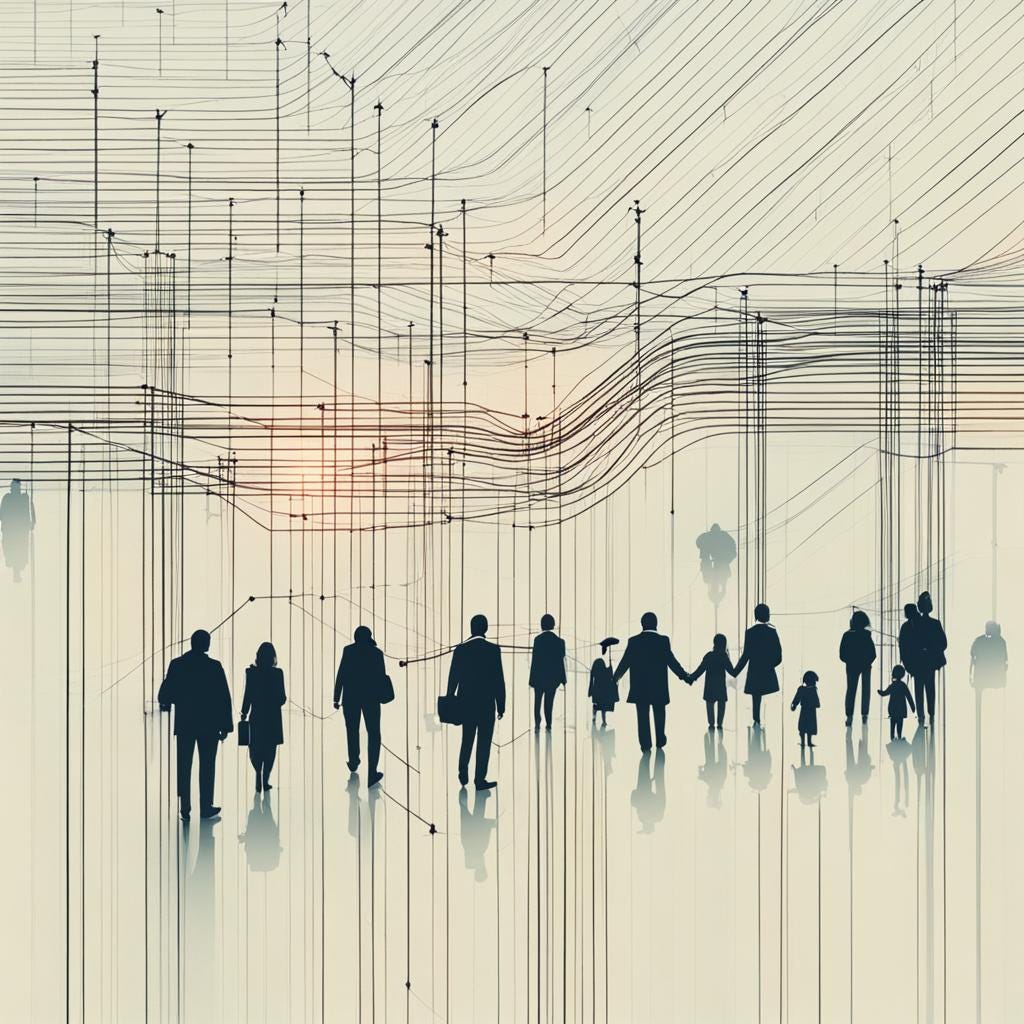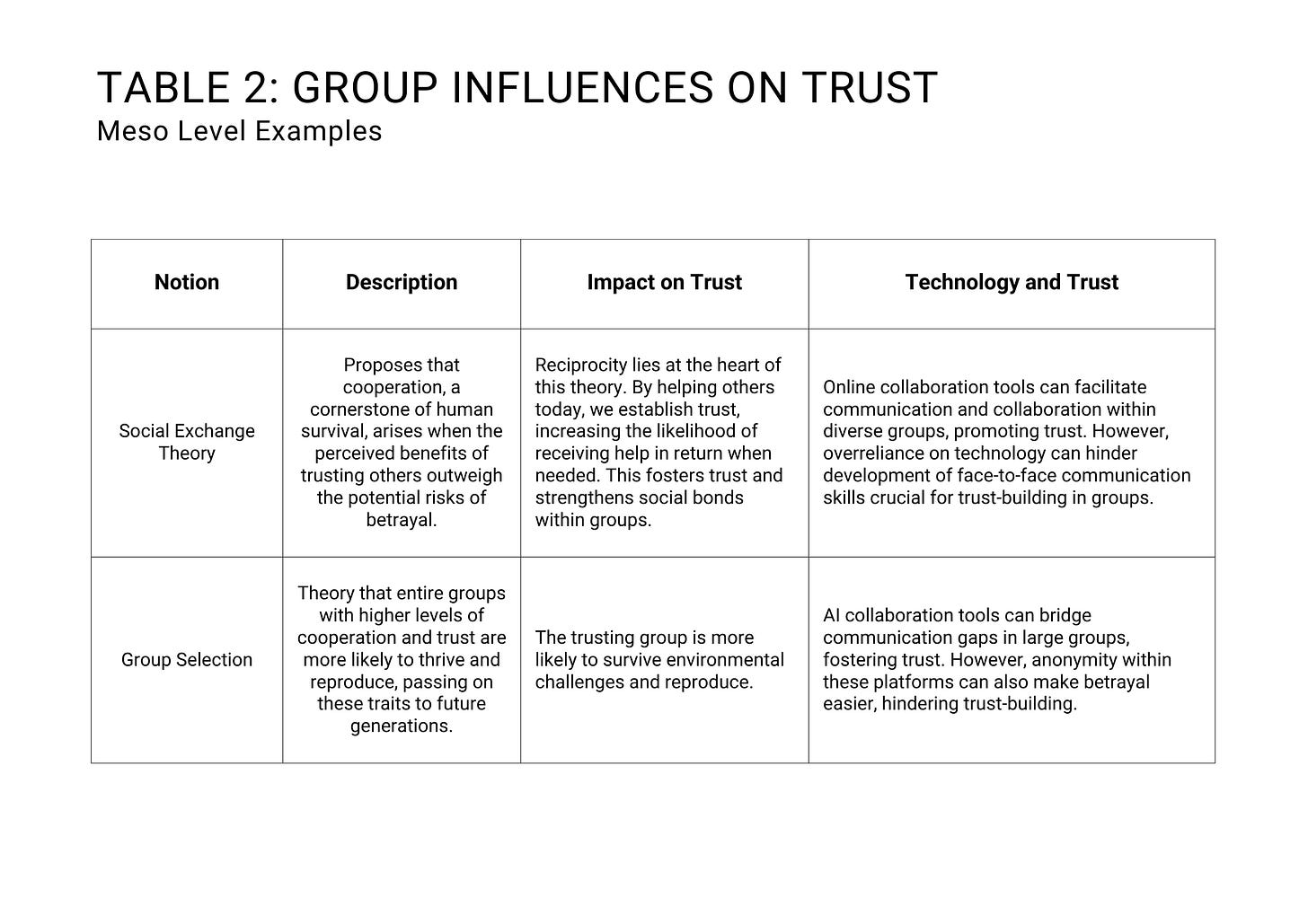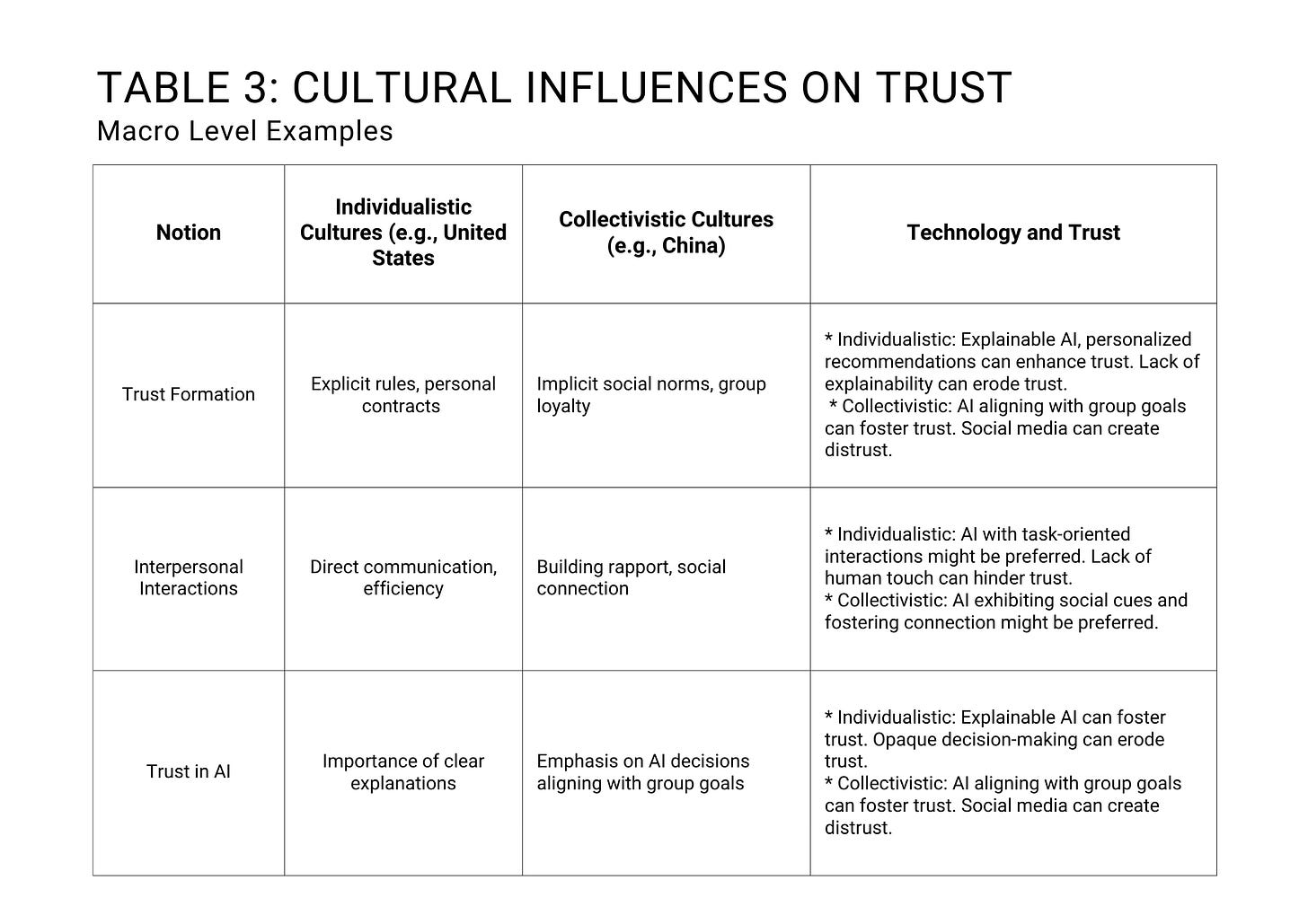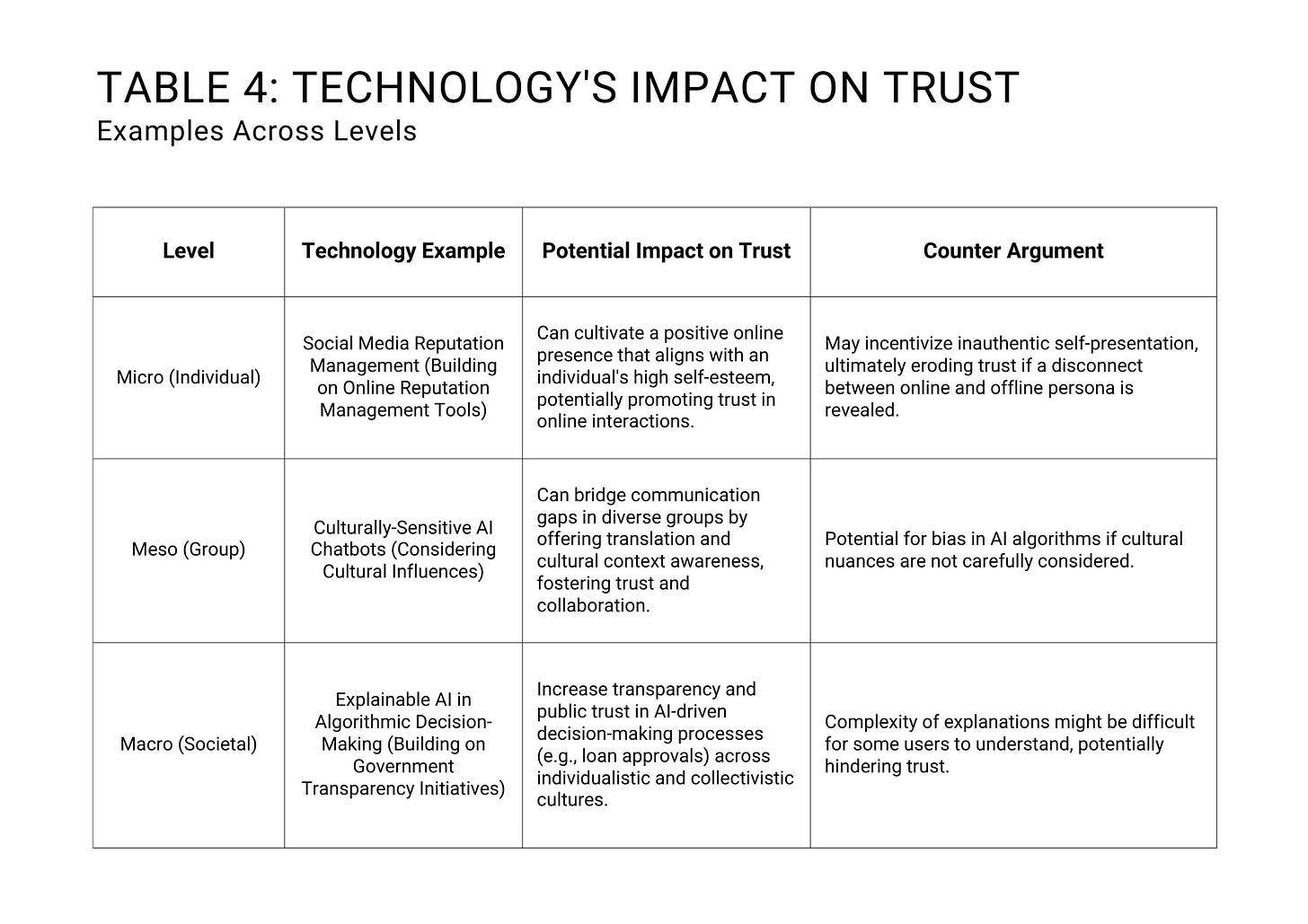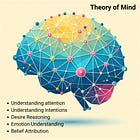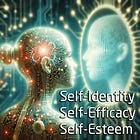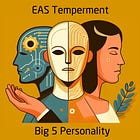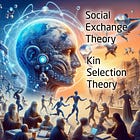Making Sense of Trust: A Psychological and Anthropological Lens on Human Connection in the Digital Age
Unveiling the Foundations of Trust in context of AI
Preface
Navigating the world is exciting, confusing, and can be at times scary. Knowing what to believe, whom to trust, and how to behave is further complicated by the continuing pressures and opportunities brought by technologies such as AI mediating our lived experience. The below serves as a culmination of Part 1 of my explorations in the ideas that inform trust and technologies. It summarizes and further contextualizes the previous articles related to trust, looking at Psychological and Anthropological notions that can help us to understand what trust means today and in the future. This exploration is admittedly incomplete and is just a beginning.
Introduction
Trust is the foundation of human interaction. It underpins collaboration and societal progress. Yet this seemingly simple concept is intricately woven from the interplay of multiple factors: individual cognition, group dynamics, cultural values, and the ever-evolving influence of technology. The multifaceted nature of trust formation can be examined at three distinct levels: micro (individual), meso (group), and macro (societal).
At the micro level our ability to understand the thoughts and intentions of others, known as Theory of Mind, plays a crucial role in building trust-based relationships. Additionally, personality traits and self-esteem influence our likelihood to trust. Moving to the meso level, group dynamics come into play. Cooperation, as highlighted by Social Exchange Theory, and the evolutionary advantage of trust within groups, demonstrated by Group Selection, are essential considerations. Finally, at the macro level, cultural values significantly shape how trust is built. Individualistic societies often emphasize explicit rules and personal contracts, while collectivistic societies prioritize group harmony and social well-being.
While these factors provide a framework for understanding trust formation, their interplay is not always straightforward. Cultural values interact with individual personality traits to influence trust behaviors. Furthermore, the digital age has introduced a new layer of complexity. Technology acts as a powerful mediator of human interaction, impacting trust at all three levels. This essay will explore these complexities, examining the evidence that highlights the interconnectedness between individual cognition, group dynamics, cultural values, and ultimately, trust. It will delve into specific examples of technologies at each level (micro, meso, macro) and how they influence trust formation in a continually dynamic world.
Individual
Our ability to trust others hinges on the intricate workings of our minds. A cornerstone of this trust-building process is Theory of Mind1, the cognitive ability to understand another person's thoughts and intentions. This skill, typically developed as children, allows us to differentiate between accidental mishaps and deliberate actions with malicious intent. Children who can grasp Theory of Mind are better equipped to form trusting relationships as they can interpret social cues and predict behavior more accurately. For instance, a child who understands that another child didn't mean to break their toy is more likely to forgive and rebuild trust.
Self-concept2 and personality traits3 also influence our trust propensity. Individuals with high self-esteem, believing in their own trustworthiness and worth, are more likely to extend trust to others. Conversely, those with lower self-esteem may struggle to trust due to anxieties about their own likability or value. Furthermore, personality traits like agreeableness and neuroticism influence our trust propensity. Agreeable individuals, known for their cooperative nature and empathy, tend to be more trusting, assuming positive intentions in others. In contrast, those high in neuroticism, prone to anxiety and negative emotions, often exhibit lower levels of trust, viewing the world with a more suspicious lens.
These factors are interconnected. For instance, individuals with high self-esteem are more likely to be open to understanding the emotions of others. Conversely, individuals with low self-esteem can have difficulty focusing on someone else's emotional state. Understanding this interplay between cognitive abilities and personality traits provides a richer picture of how our minds navigate the complexities of trust.
By understanding these cognitive influences and how technology can both support and hinder them, we gain valuable insights into how individuals navigate trust in their interactions with others.
Groups
The success of human survival has required trust. This section dives into the evolutionary advantages of trust within groups through concepts like Social Exchange Theory and Group Selection4. Social Exchange Theory proposes that cooperation, a key feature of human survival, arises when the perceived benefits of trusting others outweigh the potential risks of betrayal. Early humans who could rely on each other for hunting success, resource sharing (food, shelter), and collective defense were more likely to survive and reproduce, passing on the genes associated with trustworthiness. Reciprocity lies at the heart of this theory. By helping others today, we establish trust, increasing the likelihood of receiving help in return when needed. This back-and-forth exchange fosters trust and strengthens social bonds within groups, creating a more resilient and cooperative group.
Group Selection further emphasizes the evolutionary advantage of trust. This theory proposes that entire groups with higher levels of cooperation and trust are more likely to thrive and reproduce, passing on these traits to future generations. Imagine two early human groups: one where trust allows for effective hunting and collective defense, and another where suspicion and betrayal hinder cooperation. The trusting group is more likely to survive environmental challenges and reproduce, ultimately perpetuating the genes associated with trust.
Understanding these evolutionary principles sheds light on why trust is such a fundamental human value.
The next section will explore how cultural variations and societal norms further influence how trust is built and maintained within groups.
Culture
Cultural variations significantly influence how trust is built and maintained in human interactions, and this extends to interactions mediated by Artificial Intelligence (AI). This section explores how Individualism versus Collectivism, dimensions identified by Cultural Dimensions Theory5, shapes trust-building behaviors in AI interactions.
Individualistic cultures, like the United States, emphasize independence and self-reliance. Trust often stems from explicit rules and personal contracts. A common scenario is an American applying for a loan. Transparency in the AI's decision-making process is likely valued. They might want clear explanations for loan approvals or denials to understand factors like credit score that played a role. If the explanation remains shrouded in mystery, they might hesitate to trust the system and, consequently, the lender itself.
In contrast, Collectivistic cultures, like China, prioritize group harmony and social well-being. Trust often builds through implicit social norms and loyalty to the collective. Here, less transparent AI decision-making might be tolerated if it benefits the community. For instance, a social media algorithm prioritizing news relevant to the entire community might be trusted. In this context, trusting the AI and the information it provides translates to trusting the broader community it reflects.
Understanding these cultural nuances is crucial for building AI systems that foster trust across diverse populations.
The following section will explore how these cultural differences influence interpersonal interactions and how technology can further impact trust formation in AI-mediated interactions.
Technology
Rapidly changing technologies have ushered in a new era where technology plays a significant role in mediating our interactions and shaping how we perceive trust. This section explores the multifaceted impact of technology on trust in various aspects of our lives.
AI-powered algorithms are a double-edged sword when it comes to online trust. On the one hand, they can personalize experiences and curate information, potentially fostering a sense of connection with online platforms. Recommendation algorithms on e-commerce sites, for example, can streamline the shopping experience and build trust by suggesting products users are likely to enjoy. However, these same algorithms can also be manipulated to spread misinformation ("fake news") or create echo chambers that reinforce existing biases. Social media platforms that rely heavily on algorithms can unwittingly become breeding grounds for distrust as users are exposed only to information that confirms their existing beliefs, hindering exposure to diverse viewpoints.
The rise of automation challenges trust in institutions and professions traditionally associated with human expertise. As Artificial Intelligence (AI) takes on more complex tasks, we may begin to question the judgment of professionals replaced by algorithms. A particularly complex and difficult case is medical diagnosis initially delivered by an AI system. While such systems can analyze vast amounts of data, the lack of a human touch and the potential for errors in AI algorithms can erode trust in the medical profession as a whole. However, proponents of AI in medicine argue that explainable AI systems can mitigate these concerns by providing clear explanations for diagnoses, fostering trust and potentially improving patient outcomes.
Technology also holds immense potential for promoting trust. Online platforms can connect individuals across geographical boundaries, fostering a sense of community and shared understanding. Language translation tools like Google Translate can facilitate communication with diverse groups, potentially breaking down cultural barriers and building trust through improved communication.
By acknowledging the challenges and capitalizing on the opportunities technology presents, it is possible to create technologies which enhance trust and the human experience.
Conclusion
This comparative analysis has revealed the multifaceted nature of trust, analyzed from the perspectives of individual cognition, group dynamics, and cultural influences. This essay has explored how cognitive abilities like Theory of Mind allow us to understand others' intentions, fostering trust-based relationships. Self-esteem and personality traits also contribute to a trusting disposition. Group dynamics further shape trust, with cooperation playing a crucial role and cultural variations influencing how trust is built. Technology presents both challenges and opportunities. Harnessing the power of technology via explainable AI systems and platforms fostering diverse interactions opens the opportunity to create a digital landscape where trust remains a critical element of human interaction.
With much humility, further research is necessary to fully understand the interplay between technology and trust. How do leadership styles and group norms influence trust within groups? Can technology applications be designed to mitigate cultural biases and promote trust across diverse populations? Addressing these questions can ensure that technology that is developed continues to be an enabler of trust and collaboration for this global society.


